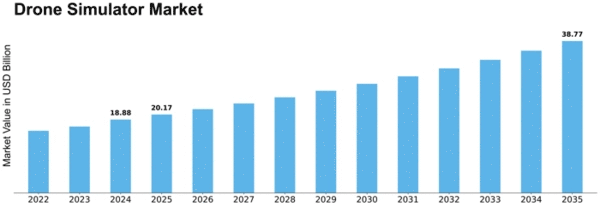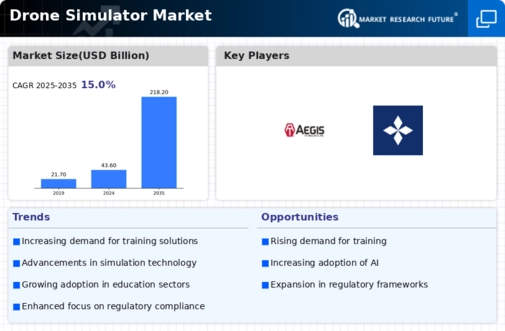-
Executive Summary
-
Market Attractiveness
- Global Drone Simulator Market, by Drone Type
- Global
-
Analysis
-
Drone Simulator Market, by Device Type
-
by Technology
-
Global Drone Simulator Market,
-
Global Drone Simulator Market, by Component
-
Global Drone Simulator Market, by End User
-
by Region
-
Global Drone Simulator Market,
-
Market Introduction
-
Market Definition
-
Scope
-
of the Study
-
Market Structure
-
Key Buying Criteria
-
Market Factor Indicator Analysis
-
Research Methodology
-
Research
-
Process
-
Primary Research
-
Secondary Research
-
Market
-
Size Estimation
-
Forecast Model
-
List of Assumptions
-
Market
-
Insights
-
Market Dynamics
-
Introduction
-
Drivers
-
Restraints
-
Opportunities
-
Challenges
-
Market/Technological
-
Trends
-
Patent Trends
-
Regulatory Landscape/Standards
-
Market Factor Analysis
-
Value Chain/Supply Chain Analysis
- R&D
- Manufacturing
- Distribution & Sales
- Post-Sales
-
Monitoring
-
Porter’s Five Forces Analysis
- Threat of New
- Bargaining Power of Buyers
- Threat of Substitutes
- Rivalry
- Bargaining Power of Supplies
-
Entrants
-
Global Drone Simulator
-
Market, by Drone Type
-
Introduction
-
8.2 Fixed-Wing
- Market Estimates &
-
Market Estimates & Forecast, 2020–2030
-
Forecast, by Region, 2020–2030
-
8.3 Multi-Rotor
- Market
- Market Estimates & Forecast,
-
Estimates & Forecast, 2020–2030
-
by Region, 2020–2030
-
Global Drone Simulator Market, by Device Type
-
Introduction
-
Fixed
- Market Estimates & Forecast,
- Market Estimates & Forecast, by Region, 2020–2030
-
Portable
- Market Estimates & Forecast, 2020–2030
- Market Estimates & Forecast, by Region, 2020–2030
-
Global
-
Drone Simulator Market, by Technology
-
Introduction
-
Augmented
- Market Estimates & Forecast, 2020–2030
-
Reality
-
Market Estimates & Forecast, by Region, 2020–2030
-
Virtual Reality
- Market Estimates & Forecast, 2020–2030
- Market Estimates
-
& Forecast, by Region, 2020–2030
-
Global Drone Simulator Market,
-
by Component
-
Introduction
-
Software
- Market Estimates
- Market Estimates & Forecast, by
-
& Forecast, 2020–2030
-
Region, 2020–2030
-
Hardware
- Market Estimates &
- Market Estimates & Forecast, by Region,
-
Forecast, 2020–2030
-
Global Drone Simulator Market, by End User
-
Introduction
-
Commercial
- Market Estimates & Forecast, 2020–2030
- Market Estimates & Forecast, by Region, 2020–2030
- Market Estimates & Forecast, 2020–2030
-
Military
-
Market Estimates & Forecast, by Region, 2020–2030
-
Global Drone
-
Simulator Market, by Region
-
Introduction
-
North America
- Market Estimates & Forecast, by Country, 2020–2030
-
Market Estimates & Forecast, by Drone Type, 2020–2030
-
Estimates & Forecast, by Device Type, 2020–2030
-
& Forecast, by Technology, 2020–2030
-
Forecast, by Component, 2020–2030
-
by End User, 2020–2030
-
Forecast, by Drone Type, 2020–2030
-
by Device Type, 2020–2030
-
by Technology, 2020–2030
-
Component, 2020–2030
-
User, 2020–2030
-
Forecast, by Drone Type, 2020–2030
-
by Device Type, 2020–2030
-
by Technology, 2020–2030
-
Component, 2020–2030
-
User, 2020–2030
-
by Country, 2020–2030
-
Type, 2020–2030
-
Market
-
Market Estimates
-
Market Estimates &
-
Market Estimates & Forecast,
-
US
-
Market Estimates &
-
Market Estimates & Forecast,
-
Market Estimates & Forecast,
-
Market Estimates & Forecast, by
-
Market Estimates & Forecast, by End
-
Canada
-
Market Estimates &
-
Market Estimates & Forecast,
-
Market Estimates & Forecast,
-
Market Estimates & Forecast, by
-
Market Estimates & Forecast, by End
-
Europe
- Market Estimates & Forecast,
- Market Estimates & Forecast, by Drone
- Market Estimates & Forecast, by Device Type,
- Market Estimates & Forecast, by Technology, 2020–2030
- Market Estimates & Forecast, by Component, 2020–2030
-
Market Estimates & Forecast, by End User, 2020–2030
-
UK
-
Market Estimates & Forecast, by Drone Type, 2020–2030
-
Market Estimates & Forecast, by Device Type, 2020–2030
-
Market Estimates & Forecast, by Technology, 2020–2030
-
Estimates & Forecast, by Component, 2020–2030
-
& Forecast, by End User, 2020–2030
-
Market
-
Market Estimates
-
Germany
-
Market Estimates & Forecast, by Drone Type, 2020–2030
-
Estimates & Forecast, by Device Type, 2020–2030
-
Estimates & Forecast, by Technology, 2020–2030
-
& Forecast, by Component, 2020–2030
-
Forecast, by End User, 2020–2030
-
Estimates & Forecast, by Drone Type, 2020–2030
-
& Forecast, by Device Type, 2020–2030
-
& Forecast, by Technology, 2020–2030
-
Forecast, by Component, 2020–2030
-
by End User, 2020–2030
-
& Forecast, by Drone Type, 2020–2030
-
& Forecast, by Device Type, 2020–2030
-
& Forecast, by Technology, 2020–2030
-
& Forecast, by Component, 2020–2030
-
Forecast, by End User, 2020–2030
-
Market
-
Market
-
Market Estimates
-
Market Estimates &
-
France
-
Market
-
Market Estimates
-
Market Estimates
-
Market Estimates &
-
Market Estimates & Forecast,
-
Italy
-
Market Estimates
-
Market Estimates
-
Market Estimates
-
Market Estimates
-
Market Estimates &
-
Rest of Europe
-
Market Estimates & Forecast, by Drone Type, 2020–2030
-
Market Estimates & Forecast, by Device Type, 2020–2030
-
Market Estimates & Forecast, by Technology, 2020–2030
-
Market Estimates & Forecast, by Component, 2020–2030
-
Estimates & Forecast, by End User, 2020–2030
-
Market
-
Asia-Pacific
- Market Estimates & Forecast, by Country, 2020–2030
-
Market Estimates & Forecast, by Drone Type, 2020–2030
-
Estimates & Forecast, by Device Type, 2020–2030
-
& Forecast, by Technology, 2020–2030
-
Forecast, by Component, 2020–2030
-
by End User, 2020–2030
-
& Forecast, by Drone Type, 2020–2030
-
Forecast, by Device Type, 2020–2030
-
Forecast, by Technology, 2020–2030
-
by Component, 2020–2030
-
End User, 2020–2030
-
Forecast, by Drone Type, 2020–2030
-
by Device Type, 2020–2030
-
by Technology, 2020–2030
-
Component, 2020–2030
-
User, 2020–2030
-
by Drone Type, 2020–2030
-
Device Type, 2020–2030
-
Technology, 2020–2030
-
by Drone Type, 2020–2030
-
by Device Type, 2020–2030
-
by Technology, 2020–2030
-
by Component, 2020–2030
-
End User, 2020–2030
-
Estimates & Forecast, by Country, 2020–2030
-
& Forecast, by Drone Type, 2020–2030
-
Forecast, by Device Type, 2020–2030
-
by Technology, 2020–2030
-
Component, 2020–2030
-
User, 2020–2030
-
by Drone Type, 2020–2030
-
Device Type, 2020–2030
-
Technology, 2020–2030
-
Type, 2020–2030
-
Type, 2020–2030
-
Rest of the Middle East & Africa
-
by Drone Type, 2020–2030
-
Device Type, 2020–2030
-
Technology, 2020–2030
-
Market
-
Market Estimates
-
Market Estimates &
-
Market Estimates & Forecast,
-
China
-
Market Estimates
-
Market Estimates &
-
Market Estimates &
-
Market Estimates & Forecast,
-
Market Estimates & Forecast, by
-
Japan
-
Market Estimates &
-
Market Estimates & Forecast,
-
Market Estimates & Forecast,
-
Market Estimates & Forecast, by
-
Market Estimates & Forecast, by End
-
India
-
Market Estimates & Forecast,
-
Market Estimates & Forecast, by
-
Market Estimates & Forecast, by
-
Market Estimates & Forecast, by Component,
-
Market Estimates & Forecast, by End User, 2020–2030
-
Rest of Asia-Pacific
-
Market Estimates & Forecast,
-
Market Estimates & Forecast,
-
Market Estimates & Forecast,
-
Market Estimates & Forecast,
-
Market Estimates & Forecast, by
-
Middle East & Africa
- Market
- Market Estimates
- Market Estimates &
- Market Estimates & Forecast,
- Market Estimates & Forecast, by
- Market Estimates & Forecast, by End
- UAE
- Saudi Arabia
-
Latin America
- Market Estimates & Forecast, by Country,
- Market Estimates & Forecast, by Drone Type, 2020–2030
- Market Estimates & Forecast, by Device Type, 2020–2030
-
Market Estimates & Forecast, by Technology, 2020–2030
-
Estimates & Forecast, by Component, 2020–2030
-
& Forecast, by End User, 2020–2030
-
Market
-
Market Estimates
-
Brazil
-
Market Estimates & Forecast, by Drone Type, 2020–2030
-
Estimates & Forecast, by Device Type, 2020–2030
-
Estimates & Forecast, by Technology, 2020–2030
-
& Forecast, by Component, 2020–2030
-
Forecast, by End User, 2020–2030
-
Market
-
Market
-
Market Estimates
-
Market Estimates &
-
Rest of Latin America
-
Market Estimates & Forecast, by Drone Type, 2020–2030
-
Estimates & Forecast, by Device Type, 2020–2030
-
Estimates & Forecast, by Technology, 2020–2030
-
& Forecast, by Component, 2020–2030
-
Forecast, by End User, 2020–2030
-
Market
-
Market
-
Market Estimates
-
Market Estimates &
-
Competitive Landscape
-
Competitive Overview
-
Competitor Dashboard
-
Major Growth Strategies
-
in the Global Drone Simulator Market
-
Competitive Benchmarking
-
Market Share Analysis
-
Key Developments & Growth Strategies
- Mergers & Acquisitions
- Joint Ventures
-
Product Launches/Service Deployments
-
Company Profiles
-
Aegis Technologies
- Company Overview
- Financial Updates
- Component/Business
- Strategy
- Key Developments
-
Segment Overview
-
SWOT Analysis
-
CAE Inc.
- Company Overview
- Financial
- Component/Business Segment Overview
- Strategy
- Key Developments
- SWOT Analysis
-
Updates
-
General Atomics
- Company Overview
- Financial Updates
- Component/Business
- Strategy
- Key Developments
-
Segment Overview
-
SWOT Analysis
-
Havelsan AS
- Company Overview
- Component/Business Segment Overview
- Key Developments
- SWOT Analysis
-
Financial Updates
-
Strategy
-
Israel
- Company Overview
- Financial Updates
- Component/Business Segment Overview
- Strategy
- SWOT Analysis
-
Aerospace Industries Ltd
-
Key Developments
-
L3 Link Training and Simulation
- Company Overview
- Financial Updates
- Component/Business
- Strategy
- Key Developments
-
Segment Overview
-
SWOT Analysis
-
Leonardo SpA
- Company Overview
- Component/Business Segment Overview
- Key Developments
- SWOT Analysis
-
Financial Updates
-
Strategy
-
Sikan
- Company Overview
- Financial Updates
- Component/Business Segment Overview
- Strategy
- SWOT Analysis
-
Nutzfahrzeuge GmbH
-
Key Developments
-
Simlat UAS Simulation
- Company Overview
- Financial Updates
- Component/Business
- Strategy
- Key Developments
-
Segment Overview
-
SWOT Analysis
-
Singapore Technologies Electronics Limited
- Financial Updates
- Component/Business
- Strategy
- Key Developments
-
Company Overview
-
Segment Overview
-
SWOT Analysis
-
Zen Technologies Limited
- Company Overview
- Financial Updates
- Component/Business Segment Overview
- Strategy
- Key Developments
- SWOT Analysis
-
Appendix
-
References
-
Related Reports
-
List
-
of Abbreviations
-
Industry Insights
-
Note: This table of contents is
-
tentative and subject to change as the research progresses.
-
List of Tables
-
Global Drone Simulator Market, by Region, 2020–2030
-
Table
-
North America: Drone Simulator Market, by Country, 2020–2030
-
Table
-
Europe: Drone Simulator Market, by Country, 2020–2030
-
Asia-Pacific:
-
Drone Simulator Market, by Country, 2020–2030
-
Middle East &
-
Africa: Drone Simulator Market, by Region, 2020–2030
-
Global Drone
-
Simulator Market, by Region, 2020–2030
-
Global Drone Simulator
-
Market, by Drone Type, 2020–2030
-
Global Drone Simulator Market,
-
by Device Type, 2020–2030
-
Global Drone Simulator Market, by
-
Technology, 2020–2030
-
Global Drone Simulator Market, by Component,
-
Global Drone Simulator Market, by End User, 2020–2030
-
North America: Drone Simulator Market, by Country, 2020–2030
-
North America: Drone Simulator Market, by Drone Type, 2020–2030
-
North America: Drone Simulator Market, by Device Type, 2020–2030
-
North America: Drone Simulator Market, by Technology, 2020–2030
-
North America: Drone Simulator Market, by Component, 2020–2030
-
North America: Drone Simulator Market, by End User, 2020–2030
-
Europe: Drone Simulator Market, by Country, 2020–2030
-
Table
-
Europe: Drone Simulator Market, by Drone Type, 2020–2030
-
Table 20
-
Europe: Drone Simulator Market, by Device Type, 2020–2030
-
Europe:
-
Drone Simulator Market, by Technology, 2020–2030
-
Europe: Drone
-
Simulator Market, by Component, 2020–2030
-
Europe: Drone Simulator
-
Market, by End User, 2020–2030
-
Asia-Pacific: Drone Simulator
-
Market, by Country, 2020–2030
-
Asia-Pacific: Drone Simulator
-
Market, by Drone Type, 2020–2030
-
Asia-Pacific: Drone Simulator
-
Market, by Device Type, 2020–2030
-
Asia-Pacific: Drone Simulator
-
Market, by Technology, 2020–2030
-
Asia-Pacific: Drone Simulator
-
Market, by Component, 2020–2030
-
Asia-Pacific: Drone Simulator
-
Market, by End User, 2020–2030
-
Middle East & Africa: Drone
-
Simulator Market, by Country, 2020–2030
-
Middle East & Africa:
-
Drone Simulator Market, by Drone Type, 2020–2030
-
Middle East
-
& Africa: Drone Simulator Market, by Device Type, 2020–2030
-
Table
-
Middle East & Africa: Drone Simulator Market, by Technology, 2020–2030
-
Middle East & Africa: Drone Simulator Market, by Component, 2020–2030
-
Middle East & Africa: Drone Simulator Market, by End User, 2020–2030
-
Latin America: Drone Simulator Market, by Country, 2020–2030
-
Latin America: Drone Simulator Market, by Drone Type, 2020–2030
-
Latin America: Drone Simulator Market, by Device Type, 2020–2030
-
Latin America: Drone Simulator Market, by Technology, 2020–2030
-
Latin America: Drone Simulator Market, by Component, 2020–2030
-
Latin America: Drone Simulator Market, by End User, 2020–2030
-
List of Figures
-
Research Process of MRFR
-
Top-Down
-
& Bottom-Up Approaches
-
Market Dynamics
-
Impact Analysis:
-
Market Drivers
-
Impact Analysis: Market Restraints
-
Porter's
-
Five Forces Analysis
-
Value Chain Analysis
-
Global Drone
-
Simulator Market Share, by Drone Type, 2020 (%)
-
Global Drone Simulator
-
Market, by Drone Type, 2020–2030 (USD Million)
-
Global Drone
-
Simulator Market Share, by Device Type, 2020 (%)
-
Global Drone Simulator
-
Market, by Device Type, 2020–2030 (USD Million)
-
Global Drone
-
Simulator Market Share, by Technology, 2020 (%)
-
Global Drone Simulator
-
Market, by Technology, 2020–2030 (USD Million)
-
Global Drone
-
Simulator Market Share, by Component, 2020 (%)
-
Global Drone Simulator
-
Market, by Component, 2020–2030 (USD Million)
-
Global Drone
-
Simulator Market Share, by End User, 2020 (%)
-
Global Drone Simulator
-
Market, by End User, 2020–2030 (USD Million)
-
Global Drone Simulator
-
Market Share (%), By Region, 2020
-
Global Drone Simulator Market,
-
by Region, 2020–2030 (USD Million)
-
North America: Drone Simulator
-
Market Share (%), 2020
-
North America: Drone Simulator Market by Country,
-
Europe: Drone Simulator Market Share
-
(%), 2020
-
Europe: Drone Simulator Market by Country, 2020–2030
-
(USD Million)
-
Asia-Pacific: Drone Simulator Market Share (%), 2020
-
Asia-Pacific: Drone Simulator Market by Country, 2020–2030 (USD
-
Million)
-
Middle East & Africa Drone Simulator Market Share (%),
-
Middle East & Africa Drone Simulator Market by Region, 2020–2030
-
(USD Million)
-
Latin America Drone Simulator Market Share (%), 2020
-
Latin America Drone Simulator Market by Region, 2020–2030 (USD
-
Million)


















Leave a Comment